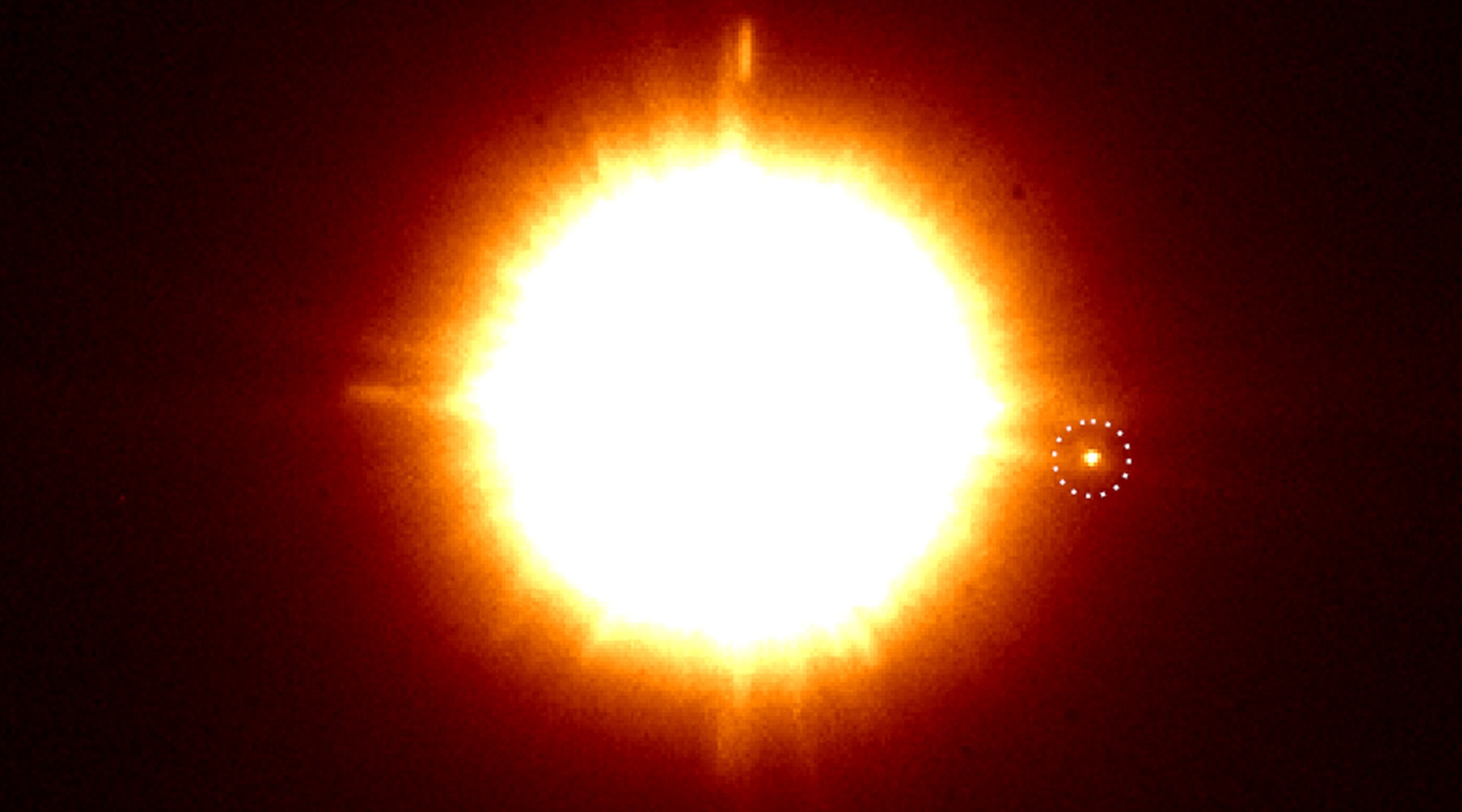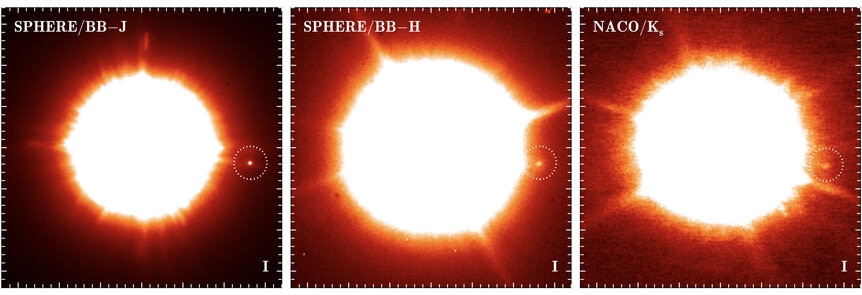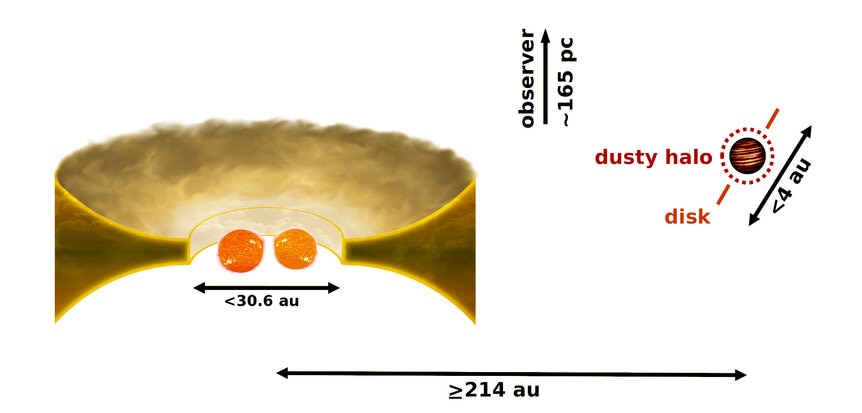Create a free profile to get unlimited access to exclusive videos, sweepstakes, and more!
Two planets discovered: One by gravity, one by accident [Part 2]

Two new exoplanets have been discovered that, while unrelated, were both found in unconventional ways. I decided to write a two-part article about them: Yesterday's, Part 1, was about a planet discovered due to its gravity affecting the light of a background star.
Today's is even odder. It was found by accident.
The star is called CS Chamaeleontis (or CS Cha for short), and it's about 540 light-years from Earth (pretty close as stars go). It's actually a binary star, two stars orbiting each other, and they're so young (less than three million years old) that they still have the disk of dust swirling around them from which they formed.
Quite a few stars are now known to still have a disk around them. Observing those disks can reveal a lot about the conditions under which stars form, something that's generally difficult for astronomers to study. In this case, CS Cha is close enough to us that the disk is resolvable (that is, can be seen as a disk instead of an unresolved dot) by powerful telescopes.
A team of astronomers targeted CS Cha with the mammoth Very Large Telescope (or VLT) in Chile, an 8.2-meter monster that has exceptionally good resolution. They used a camera called SPHERE, itself designed to look for planets and disks around nearby stars. What the astronomers were expecting to see was the disk, and hopefully too an "inner cavity," a region near the stars where the dust has been cleared out by their light and stellar winds.
They did indeed see the disk (though not the inner cavity, which means it must be smaller than about 2.3 billion kilometers in size) and found it to be smooth, slightly inclined to our view, and with an outer radius of about 8.3 billion kilometers. That's nearly twice the distance of Neptune from the Sun, so it's a big disk!
However, their attention was caught by a spark of light even farther out. In the images it's just a dot, but clearly visible. Could it be a planet?
You have to be careful here; the sky is filled with stars, and a faint background star can just by chance happen to lie near the position of a much closer one. The best way to figure that out is to see if the two objects move together in the sky over a long period of time; a background star will stay put while a companion planet will move with the star. You can either wait and take more images, or go look at older observations and see if it's there in them*.
The latter is easier, so the astronomers went into the archives for Hubble Space Telescope and the VLT. They found images of CS Cha… and they saw the object! It was very faint in the Hubble images, and much more obvious in the VLT images. A very careful analysis of the positions of the star and second object showed it was in fact moving along with the star, and gravitationally bound to it. It's a true companion!
But what is it?
You have to be careful here too. A planet just 2 or 3 million years old will still be hot from the energy of its formation, so it glows. How bright it is depends on its mass; a bigger planet will be more luminous. The colors at which it glows change with mass as well.
So they looked at their observations and compared them to models of young planets, trying to find a good fit. But they had trouble; an object with five times Jupiter's mass fit some of their data, but not others. Then they realized that the object might too be surrounded by a disk of dust like the host binary star is. When they used models that included that, the best fit they found was for an object with about 20 times Jupiter's mass, but enshrouded by dust.
Something with a mass that high is less likely to be a planet and more likely to be a brown dwarf, an astronomical object intermediate between planets and stars. In that mass regime it can be hard to tell the difference, especially when the object is young. Some astronomers argue that the difference between a low mass brown dwarf and a high mass planet is how they form (a brown dwarf forms like a star, via collapse from a disk of gas and dust, whereas a planet forms from small pieces of rubble that build up over time; the former is called top-down formation and the latter bottom-up).
Given how far the object is from the binary star — a staggering 31 billion kilometers, about six times farther out than Neptune is from the Sun — it's hard to see how a planet could form out there. The disk of material would be mighty thin, or even non-existent that far out. It seems more likely it formed from collapse of a gas cloud itself, like a star. It turns out the disk around it is probably tilted at a different angle than the disk around the binary, which again points more toward a collapse scenario where it formed on its own farther out (if it formed like a planet its disk would more likely be aligned with the stars' disk).
If I had to bet, I'd call it a brown dwarf, but the astronomers wisely won't make that claim in their paper. Further observations may help nail that down.
Still, that's cool! They got all the science they needed about the stars and their disk, and got a nice little bonus too. It was a bit of luck, one that adds another low-mass companion to our catalogs, and also sits on the border between two different kinds of objects, perhaps giving us clues about both. That's quite a happy accident!
*Many years ago, when I worked on Hubble, there was an observation of a nearby star with a source next to it that might have been a planet. This was before any exoplanet had been directly seen, so if it panned out we would've been the first ever to find one that way! Sadly, observations taken a year or so later showed that was a background star or possibly a galaxy. Ah well.
















